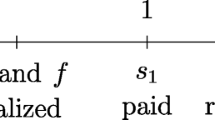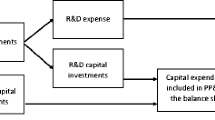Abstract
To investigate the relationship between managerial compensation and research and development (R&D) investment under asymmetric information, this paper establishes a two-period principal-agency model, in which the firm owner hires a risk-averse manager to operate the firm and to make the R&D investment decision. The manager has private information regarding the profitability of the R&D investment. Firstly, we present an R&D investment problem under symmetric information as the benchmark. Then, we discuss the scenario with asymmetric information about the profitability, and the firm owner offers new optimal incentive contact. We compare the differences of the company’s R&D investment decisions and choices of the compensation contract under symmetric and asymmetric information cases by numerical experiments. We find that the manager receives an upward distortion in the first-period bonus share rate, and a downward distortion in the second-period bonus share rate. Meanwhile, the R&D investment is less than the symmetric information case. At last, the variable outside option has no effect on the optimal manager’s compensation contract when the marginal cost of R&D investment is relatively small or under symmetric information case.






Similar content being viewed by others
Notes
Many common distributions satisfy this assumption, such as uniform, normal, exponential, and power function distributions (Bagnoli and Bergstrom 2005).
There are other kinds of contracts in the literature, such as log-linear contract (Edmans and Gabaix 2011) and general nonlinear contract (Hölmstrom 1979; Oyer 1998; Edmans and Gabaix 2016). But linear incentive contracts are still commonly used in the literature. Lambert (2001) summarized three common justifications for the linear contracting restriction: (1) optimal in a richer (but typically unmodeled) setting; (2) commonly used in practice; and (3) simply their tractability.
References
Bagnoli M, Bergstrom T (2005) Log-concave probability and its applications. Econ Theory 26(2):445–469
Alam P, Liu M, Peng X (2014) R&D expenditures and implied equity risk premiums. Rev Quant Financ Account 43(3):441–462
Arqub OA, Mohammed AS, Momani S, Hayat T (2016) Numerical solutions of fuzzy differential equations using reproducing kernel Hilbert space method. Soft Comput 20(8):3283–3302
Arqub OA, Abo-Hammour Z (2014) Numerical solution of systems of second-order boundary value problems using continuous genetic algorithm. Inf Sci 279:396–415
Abo-Hammour Z, Abu Arqub O, Momani S, Shawagfeh N (2014) Optimization solution of Troeschs and Bratus problems of ordinary type using novel continuous genetic algorithm. Discrete Dyn Nat Soc, 2014, Article ID 401696, p 15
Barker VL III, Mueller GC (2002) CEO characteristics and firm R&D spending. Manag Sci 48(6):782–801
Balkin DB, Markman GD, Gomez-Mejia LR (2000) Is CEO pay in high-technology firms related to innovation? Acad Manag J 43(6):1118–1129
Bolton P, Dewatripont M (2005) Contract theory. MIT press, Cambridge
Cao J, Laksmana I (2010) The effect of capital market pressures on the association between R&D spending and CEO option compensation. Rev Quant Financ Account 34(2):273–300
Chao R, Lichtendahl K, Grushka-Cockayne Y (2014) Incentives in a stage-gate process. Prod Oper Manag 23(8):1286–1298
Chen Y (2013) Risk incentives trade-off and outside options. OR Spectr 35(4):937–956
Chen SS, Ho KY, Ho PH (2014) CEO overconfidence and long-term performance following R&D increases. Financ Manag 43(2):245–269
Chen LY, Chen YF, Yang SY (2017) Managerial incentives and R&D investments: the moderating effect of the directors and officers liability insurance. N Am J Econ Financ 39:210–222
Cheng S (2004) R&D expenditures and CEO compensation. Account Rev 79(2):305–328
Edmans A, Gabaix X (2011) Tractability in incentive contracting. Rev Financ Stud 24(9):2865–2894
Edmans A, Gabaix X (2016) Executive compensation: a modern primer. J Econ Lit 54(4):1232–87
Hölmstrom B (1979) Moral hazard and observability. Bell J Econ 10(1):74–91 (1979)
Gibbons R (1998) Incentives in organizations. J Econ Perspect 12:115–132
Dutta S, Reichelstein S (2002) Controlling investment decisions: depreciation and capital charges. Rev Account Stud 7(2–3):253–281
Dutta S (2003) Capital budgeting and managerial compensation: incentive and retention effects. Rev Account 78(1):71–93
Dutta S, Fan Q (2009) Hurdle rates and project development efforts. Account Rev 84(2):405–432
Dutta S, Fan Q (2014) Equilibrium earnings management and managerial compensation in a multiperiod agency setting. Rev Account Stud 19(3):1047–1077
Jensen MC, Murphy KJ (1990) Performance pay and top-management incentives. J Polit Econ 98(2):225–264
Jullien B (2000) Participation constraints in adverse selection models. J Econ Theory 93(1):1–47
Lambert RA (2001) Contracting theory and accounting. J Account Econ 32(1–3):3–87
Lin C, Lin P, Song FM, Li C (2011) Managerial incentives, CEO characteristics and corporate innovation in Chinas private sector. J Comp Econ 39(2):176–190
Meza D, Webb D (2007) Incentive design under loss aversion. J Eur Econ Assoc 5(1):66–92
Murphy K (2000) Performance standards in incentive contracts. J Account Econ 30(3):245–278
Oyer P (1998) Fiscal year ends and nonlinear incentive contracts: the effect on business seasonality. Quant J Econ 113(1):149–185
Rasul I, Sonderegger S (2010) The role of the agent’s outside options in principal-agent relationships. Game Econ Behav 68(2):781–788
Shen CHH, Zhang H (2013) CEO risk incentives and firm performance following R&D increases. J Bank Financ 37(4):1176–1194
Sheikh S (2012) Do CEO compensation incentives affect firm innovation? Rev Account Financ 11(1):4–39
Wu J, Tu R (2007) CEO stock option pay and R&D spending: a behavioral agency explanation. J Bus Res 60(5):482–492
Xiao T, Yang D (2009) Risk sharing and information revelation mechanism of a one-manufacturer and one-retailer supply chain facing an integrated competitor. Eur J Oper Res 196(3):1076–1085
Xu C, Yan M (2014) Radical or incremental innovations R&D investment around CEO retirement. J Account Audit Financ 29(4):547–576
Yang K, Zhao R, Lan Y (2016) Impacts of uncertain project duration and asymmetric risk sensitivity information in project management. Int Trans Oper Res 23(4):749–774
Yang K, Zhao R, Lan Y (2016) Incentive contract design in project management with serial tasks and uncertain completion times. Eng Optim 48(4):629–651
Zona F (2016) Agency models in different stages of CEO tenure: the effects of stock options and board independence on R&D investment. Res Policy 45(2):560–575
Acknowledgements
This work was supported by Natural Science Foundation of Hebei Province of China (F2015201142) and Humanities Social Sciences Research Project of Colleges and Universities in Hebei Province (SD171005).
Author information
Authors and Affiliations
Corresponding author
Ethics declarations
Conflict of interest
The authors declare that there is no conflict of interest regarding the publication of this article.
Human and animals participants
This article does not contain any studies with human participants or animals performed by any of the authors.
Additional information
Communicated by X. Li.
Rights and permissions
About this article
Cite this article
Zhao, Z., Yang, G. & Xu, J. Managerial compensation and research and development investment in a two-period agency setting. Soft Comput 22, 5453–5465 (2018). https://doi.org/10.1007/s00500-018-3132-y
Published:
Issue Date:
DOI: https://doi.org/10.1007/s00500-018-3132-y




